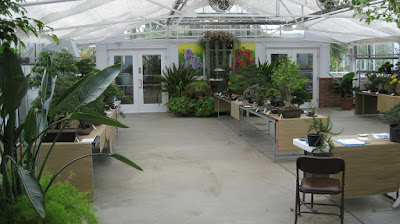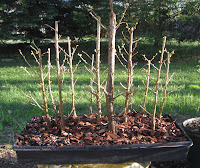While our hardy trees are dormant and tucked away under the mulch and snow, winter is the time of the year when you might have a chance to do some bonsai studying--and perhaps hone or expand on bonsai skills, get ideas for projects, and maybe find some inspiration from other clubs, books and posts from other tree people.
 |
| A project in DeGroot's book |

 This time of the year I like to sit and review some of my favorite books. One book that I come back to again and again is a small book by David DeGroot, entitled Basic Bonsai Design. It that was designed for workshops, and is a small wire bound book. What I have always liked about it is that it lays out some basic principals along with a few projects where the author begins with nursery stock. For someone new to the art, it shows a clear path for creating your own bonsai. He discusses the process of visualizing and planning a project, making the initial pruning and wiring to begin to develop the tree. It is concisely written and easy to follow. I used this section several years ago when I started some literati pine projects. I thought it was very helpful. The book is available through the American Bonsai Society at this link for $16.
This time of the year I like to sit and review some of my favorite books. One book that I come back to again and again is a small book by David DeGroot, entitled Basic Bonsai Design. It that was designed for workshops, and is a small wire bound book. What I have always liked about it is that it lays out some basic principals along with a few projects where the author begins with nursery stock. For someone new to the art, it shows a clear path for creating your own bonsai. He discusses the process of visualizing and planning a project, making the initial pruning and wiring to begin to develop the tree. It is concisely written and easy to follow. I used this section several years ago when I started some literati pine projects. I thought it was very helpful. The book is available through the American Bonsai Society at this link for $16.The internet is an inexhaustible library for information to help with bonsai skills and ideas. I enjoy looking at photos of the trees that other clubs publish. It's just exciting to see what other clubs and well-known bonsai artists produce. There are two places that I really like and have found myself going back to over and over again--one for just plain and simple joy and inspiration, and another that excites me to think more ambitiously about working on seemingly impossible material.
 |
| Example of inspiring sequence on TedyBoy's blog |
The second internet spot that I have kept going back to are the Youtube posts by the English bonsai artist Graham Potter. Potter has made me think about how I might be able to move to the next level and reach for more ambitious projects and ways of creating bonsai. Also, he often works on material that is similar to what I like best-- an old beat up shrub that the neighbors have ripped out of their lawns and put out on the curb. His series of videos are practically an on-line course in the art of carving and conceiving what can be done with this type of large material. Take a moment or two to watch one of his videos, you won't be disappointed and it will start you thinking of what projects are possible if you can get that discarded shrub to live in a pot.
Shapes on the Winter Skyline
Winter is also a good opportunity to really study shapes. The bare winter tree lines with their black branches against the gray sky make for a wonderful study of shapes.
One of the skills that I most admire in other bonsai people is the ability to make a good, interesting and believable apex. Along the winter skyline, you can catch some of the phenomenal apexes that nature creates. Sometimes the snow sort of highlights curves and features of trees. If you have a camera handy, photographing such magnificent trees can serve as a reference of what trunk movement near the top really looks like. They can also inspire. The old Scots pine (photo) near a cemetery in Kent, Ohio is practically a classic literati bunjin style. Nature just shows you how its done.
Anyway, that will keep you thinking and getting ready for a new season. The best is yet to come.
















































